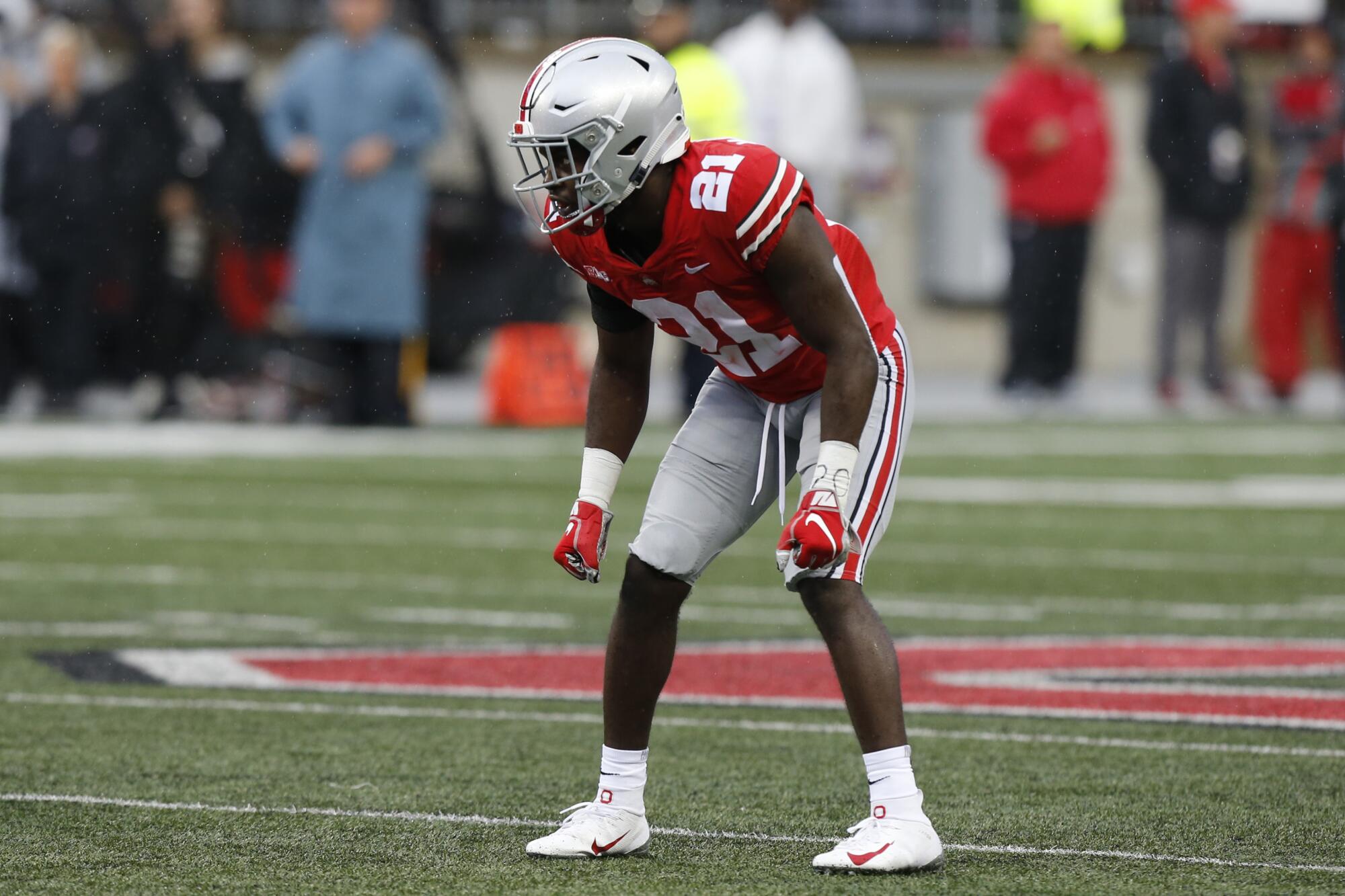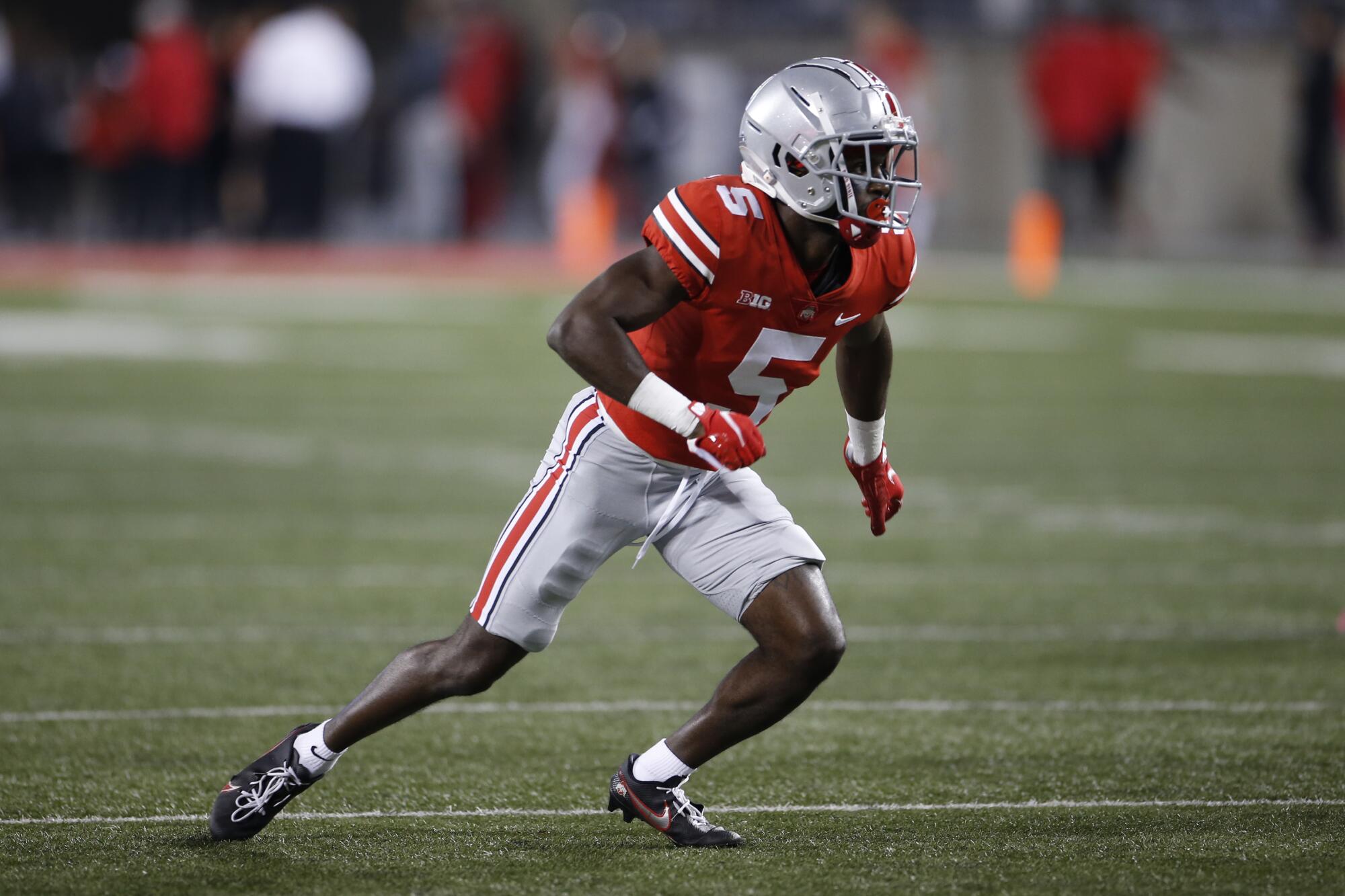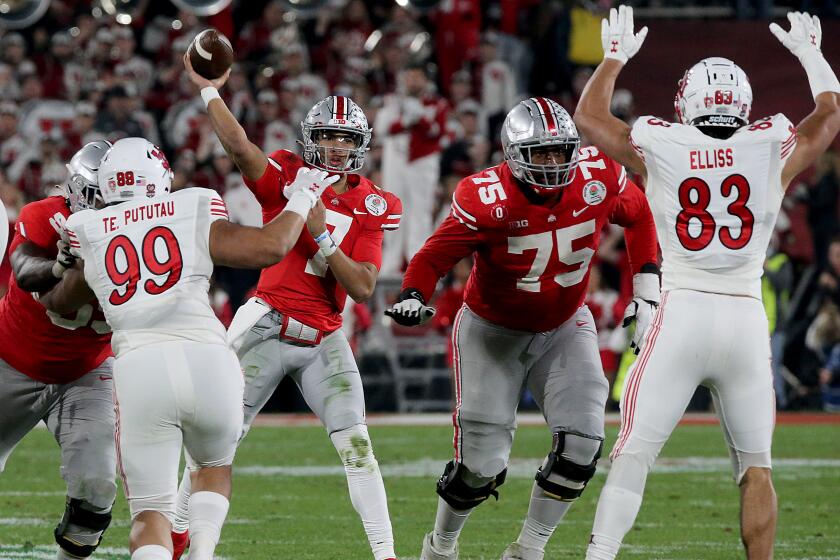
- Share via
Throughout his career as a cornerback at Ohio State, Marcus Williamson had never tried to become a social media star. He wanted to be known for his focus in the classroom and on the field, not begging for attention that would only distract him from his goals.
But during the second quarter of Saturday’s Rose Bowl, back in Columbus watching a game in which he very well could have been playing, he dipped a toe into Twitter. The Buckeyes were trailing Utah 28-14 in the second quarter when he posted that he was praying for two teammates who had just been injured on the same play. Shortly thereafter, he waded deeper, asking, “How did we give up 35 in the first half?”
Williamson had not planned this. Once he got going, though, it was like “a little dopamine hit,” he would say four days later. Fans from all over the country, many of whom were a part of the nearly 20 million who tuned into “The Granddaddy of Them All,” found themselves transfixed. Why — or, rather, how — was an Ohio State player publicly calling out his own teammates and coaches midgame?
Commentary: Rose Bowl wasn’t a mere game. It was Ohio State and Utah’s rebuke to Kirk Herbstreit
Ohio State’s exciting comeback victory over Utah in a gutsy Rose Bowl thriller showed that college football players do indeed put the game first.
Truth was, it had been an eye-opening month for Williamson, a graduate student who said he believed he had put five years of himself into being a good Buckeye. After Ohio State’s crushing loss to Michigan, for the first time in his career he took time to reflect with the season freshly behind him, since the team didn’t have to prepare for the Big Ten championship game like usual.
“It was really weird to just sit at home and be watching the games, not practicing, the coaches are off recruiting, and I said, ‘Wow, I feel so good, so relaxed, to just … not have to hit anybody in a week,’ ” Williamson explained in an interview with The Times on Wednesday. “Just feeling how great my mood was, how calm I felt, I told my parents, ‘I just enjoy my brain and my health way too much to be hitting people.’ ”
Once Rose Bowl practices began, along with chatter about the upcoming NFL draft process, Williamson realized he simply couldn’t do it any longer. He decided to retire from football, passing up that final trip to Pasadena — and his childhood dream of playing in the NFL, the dream that had brought him to Columbus.
“Just feeling how great my mood was, how calm I felt, I told my parents, ‘I just enjoy my brain and my health way too much to be hitting people.’ ”
As the Rose Bowl drama mounted, and the momentum pivoted, in the second half of Ohio State’s 48-45 victory, Williamson kept going, even egging on Buckeye Nation, saying, “u fans kno nothing and have some of THE worst football IQ ever.”
His parents, Marlon and Tamar, called him.
“Marcus,” they said, “stop tweeting.”

“The head coaches are the highest-paid employees in the state. So that just seems really off, especially when you consider the toll it’s taking on our kids.”
— Marcus Williamson
But something had been awakened, and as the minutes passed into the first night of a new year, Williamson couldn’t stop. He had been reminiscing in recent weeks about his life as a major college football player, and now he was thinking about the kids who look up to him in his hometown of Westerville, Ohio.
While his first batch of tweets spilled out spur of the moment, the words to come would be crafted more carefully, honoring his bachelor’s degree in history and minor in English, and his three appearances on the All-Academic Big Ten team.
“I wanna rap bout my career as a young black college athlete at the highest level. As guidance for u go getters coming up,” he began.
“As a 17 [year old] early enrollee,” he wrote, “Urban Meyer told me he’d ‘ruin my f—- life’ if he ever caught me smoking [marijuana]”
“It makes you wonder… How much control do these institutions have over our young black boys?” he continued.
Williamson then posted a photo of Trayvon Martin, the Black teenager shot and killed by George Zimmerman in February 2012. Martin had been wearing a hooded sweatshirt, and, in the near-decade to follow, wearing a “hoodie” became a form of protest against police brutality against Blacks.
Pac-12 Commissioner George Kliavkoff talks about misconceptions with the conference and why Lincoln Riley’s hiring by USC didn’t surprise him.
“My first team meeting. (True story 2017) This photo was presented to us via PowerPoint to institute our rule of ‘no hoods’ in the building,” Williamson wrote.
“After said meeting — the freshman and myself go to sign the hours of paperwork essentially signing our rights as Americans over to osu and the governing bodies.”
Williamson knew he could not get people to fully comprehend the sacrifices he and his teammates made and the injustices they faced, no matter how many 280-character posts he strung together.
“So I kind of took the ones that always kind of stuck to me and tried to paint a picture,” Williamson said Wednesday. “And it was a little abstract. But I believe it did its job.”
Williamson’s thread quickly spread, reminding college football fans who were blissed out by a thrilling day of big-time bowl games of the systemic ills beneath the glossy surface.
For some, he became a poster child for what’s wrong with today’s supposedly “entitled” athlete. For others, he represented a growing courage in the next generation to make change.
As a four-star recruit in high school, all he wanted was to pick a college that could help get him to the NFL. Westerville was a Northern suburb of Columbus, and it just so happened that no program was getting more cornerbacks drafted in the first round than Urban Meyer’s Ohio State.
Not long into his time there, Williamson was shaken by the death of Maryland football player Jordan McNair, who died two weeks after collapsing and being unable to recover from a strenuous summer workout in 2018.

“I love football, but we play a super violent sport, and running my head into people, the headaches and nausea that can ensue, isn’t how I want to live my 20s.”
— Marcus Williamson
“So you start to say, like, is this really what we signed up for?” Williamson said. “And going back to 2020, the pandemic, to be playing in those conditions and to not be paid, enduring what was almost like a pseudo bubble in that we could not see our families if we wanted to stay safe to participate, not going to class, truly insulated in the facility and your apartment, you start to say, wow, it almost felt like we were essential workers.
“They needed us to participate to get some sort of revenue for what keeps a lot of things afloat, what is a staple in our communities, our cities, our states. Ohio State, Alabama, these sort of schools, are the pro teams of their cities. They’re the cult following of their states. The head coaches are the highest-paid employees in the state. So that just seems really off, especially when you consider the toll it’s taking on our kids.”
Williamson battled a serious shoulder injury throughout his career at Ohio State, where he persevered to start all eight games of the Buckeyes’ 2020 season.
Dealing with his injury, he said he was made to feel expendable by coaches, and he would restore his value by playing on, even as a doctor told him he was surprised he could get out of bed.
“I’m just ready for new things in my life,” he said. “I’m looking to maybe have a less stressful environment to explore my other talents and skills. I love football, but we play a super violent sport, and running my head into people, the headaches and nausea that can ensue, isn’t how I want to live my 20s.”
Williamson closed that chapter of his journey with a bang on New Year’s Day. The reaction has been mostly positive, with players reaching out and sharing their own stories. Of course, current and former Ohio State players came out, too, to deny the cultural accusations he made about Meyer’s program.
After a one-year sojourn to Texas, the Rose Bowl returned to Pasadena, hosting fans both eager and emotional to be part of the experience.
Meyer himself was asked about the Trayvon Martin story and told Ohio State insider Jeff Snook, “That is absolutely false, and you can check with any other player on my teams during that time to confirm what I am saying. Other players know what he is saying is false. I would never do that. He is crossing the line here.”
Williamson heard what Meyer said and was able to laugh it off. But until speaking with The Times on Wednesday, he had not heard that Meyer backed off his denial, telling the Columbus Dispatch that the Martin photo was indeed used by one of his staffers but that Meyer had been unaware of it.
Williamson does not know what his path will be now that he is done with football.
“Still figuring that out,” he said. “Truth-telling seems to be first on the list so far.”
More to Read
Go beyond the scoreboard
Get the latest on L.A.'s teams in the daily Sports Report newsletter.
You may occasionally receive promotional content from the Los Angeles Times.














